PRADAXA- dabigatran etexilate pellet
Pradaxa by
Drug Labeling and Warnings
Pradaxa by is a Prescription medication manufactured, distributed, or labeled by Boehringer Ingelheim Pharmaceuticals, Inc., Bidachem S.p.a., Boehringer Ingelheim Pharma GmbH and Co. KG, Catalent Germany Schorndorf GmbH, Sixarp, LLC. Drug facts, warnings, and ingredients follow.
Drug Details [pdf]
-
HIGHLIGHTS OF PRESCRIBING INFORMATION
These highlights do not include all the information needed to use PRADAXA Oral Pellets safely and effectively. See full prescribing information for PRADAXA Oral Pellets.
PRADAXA® (dabigatran etexilate) oral pellets
Initial U.S. Approval: 2010WARNING: (A) PREMATURE DISCONTINUATION OF PRADAXA INCREASES THE RISK OF THROMBOTIC EVENTS, and (B) SPINAL/EPIDURAL HEMATOMA
See full prescribing information for complete boxed warning
(A) PREMATURE DISCONTINUATION OF PRADAXA INCREASES THE RISK OF THROMBOTIC EVENTS: Premature discontinuation of any oral anticoagulant, including PRADAXA, increases the risk of thrombotic events. To reduce this risk, consider coverage with another anticoagulant if PRADAXA is discontinued for a reason other than pathological bleeding or completion of a course of therapy (2.5, 2.6, 2.7, 5.1).
(B) SPINAL/EPIDURAL HEMATOMA: Epidural or spinal hematomas may occur in patients treated with PRADAXA who are receiving neuraxial anesthesia or undergoing spinal puncture. These hematomas may result in long-term or permanent paralysis (5.3). Monitor patients frequently for signs and symptoms of neurological impairment and if observed, treat urgently. Consider the benefits and risks before neuraxial intervention in patients who are or who need to be anticoagulated (5.3).
INDICATIONS AND USAGE
PRADAXA Oral Pellets are a direct thrombin inhibitor indicated:
- For the treatment of venous thromboembolic events (VTE) in pediatric patients aged 3 months to less than 12 years of age who have been treated with a parenteral anticoagulant for at least 5 days (1.1)
- To reduce the risk of recurrence of VTE in pediatric patients aged 3 months to less than 12 years of age who have been previously treated (1.2)
DOSAGE AND ADMINISTRATION
- Treatment of Pediatric Venous Thromboembolic Events (VTE):
- Reduction in the Risk of Recurrence of Pediatric VTE:
- Pradaxa Oral Pellets are NOT substitutable on a milligram-to-milligram basis with other dabigatran etexilate dosage forms (2.1)
- Review recommendations for converting to or from other oral or parenteral anticoagulants (2.5, 2.6)
- Temporarily discontinue PRADAXA before invasive or surgical procedures when possible, then restart promptly (2.7)
DOSAGE FORMS AND STRENGTHS
Oral pellets: 20 mg, 30 mg, 40 mg, 50 mg, 110 mg, 150 mg per packet (3)
CONTRAINDICATIONS
WARNINGS AND PRECAUTIONS
ADVERSE REACTIONS
Most common adverse reactions (> 15%) are gastrointestinal adverse reactions and bleeding. (6.1)
To report SUSPECTED ADVERSE REACTIONS, contact Boehringer Ingelheim Pharmaceuticals, Inc. at (800) 542-6257 or FDA at 1-800-FDA-1088 or www.fda.gov/medwatch.
DRUG INTERACTIONS
See 17 for PATIENT COUNSELING INFORMATION and Medication Guide.
Revised: 6/2025
-
Table of Contents
FULL PRESCRIBING INFORMATION: CONTENTS*
WARNING: (A) PREMATURE DISCONTINUATION OF PRADAXA INCREASES THE RISK OF THROMBOTIC EVENTS, and (B) SPINAL/EPIDURAL HEMATOMA
1 INDICATIONS AND USAGE
1.1 Treatment of Venous Thromboembolic Events in Pediatric Patients
1.2 Reduction in the Risk of Recurrence of Venous Thromboembolic Events in Pediatric Patients
2 DOSAGE AND ADMINISTRATION
2.1 Important Dosage Information
2.2 Recommended PRADAXA Oral Pellets Dosage for Pediatric Patients
2.3 Dosage Adjustments
2.4 Administration
2.5 Converting from or to Warfarin
2.6 Converting from or to Parenteral Anticoagulants
2.7 Discontinuation for Surgery and Other Interventions
3 DOSAGE FORMS AND STRENGTHS
4 CONTRAINDICATIONS
5 WARNINGS AND PRECAUTIONS
5.1 Increased Risk of Thrombotic Events after Premature Discontinuation
5.2 Risk of Bleeding
5.3 Spinal/Epidural Anesthesia or Puncture
5.4 Thromboembolic and Bleeding Events in Patients with Prosthetic Heart Valves
5.5 Effect of P-gp Inducers and Inhibitors on Dabigatran Exposure
5.6 Increased Risk of Thrombosis in Patients with Triple-Positive Antiphospholipid Syndrome
6 ADVERSE REACTIONS
6.1 Clinical Trials Experience
6.2 Postmarketing Experience
7 DRUG INTERACTIONS
8 USE IN SPECIFIC POPULATIONS
8.1 Pregnancy
8.2 Lactation
8.3 Females and Males of Reproductive Potential
8.4 Pediatric Use
8.5 Geriatric Use
8.6 Renal Impairment
10 OVERDOSAGE
11 DESCRIPTION
12 CLINICAL PHARMACOLOGY
12.1 Mechanism of Action
12.2 Pharmacodynamics
12.3 Pharmacokinetics
13 NONCLINICAL TOXICOLOGY
13.1 Carcinogenesis, Mutagenesis, Impairment of Fertility
14 CLINICAL STUDIES
14.1 Treatment of VTE in Pediatric Patients
14.2 Reduction in the Risk of Recurrence of VTE in Pediatric Patients
16 HOW SUPPLIED/STORAGE AND HANDLING
17 PATIENT COUNSELING INFORMATION
- * Sections or subsections omitted from the full prescribing information are not listed.
-
BOXED WARNING
(What is this?)
WARNING: (A) PREMATURE DISCONTINUATION OF PRADAXA INCREASES THE RISK OF THROMBOTIC EVENTS, and (B) SPINAL/EPIDURAL HEMATOMA
(A) PREMATURE DISCONTINUATION OF PRADAXA INCREASES THE RISK OF THROMBOTIC EVENTS
Premature discontinuation of any oral anticoagulant, including PRADAXA, increases the risk of thrombotic events. If anticoagulation with PRADAXA is discontinued for a reason other than pathological bleeding or completion of a course of therapy, consider coverage with another anticoagulant [see Dosage and Administration (2.5, 2.6, 2.7) and Warnings and Precautions (5.1)].
(B) SPINAL/EPIDURAL HEMATOMA
Epidural or spinal hematomas may occur in patients treated with PRADAXA who are receiving neuraxial anesthesia or undergoing spinal puncture. These hematomas may result in long-term or permanent paralysis. Consider these risks when scheduling patients for spinal procedures. Factors that can increase the risk of developing epidural or spinal hematomas in these patients include:
- use of indwelling epidural catheters
- concomitant use of other drugs that affect hemostasis, such as non-steroidal anti-inflammatory drugs (NSAIDs), platelet inhibitors, other anticoagulants
- a history of traumatic or repeated epidural or spinal punctures
- a history of spinal deformity or spinal surgery
- optimal timing between the administration of PRADAXA and neuraxial procedures is not known [see Warnings and Precautions (5.3)].
Monitor patients frequently for signs and symptoms of neurological impairment. If neurological compromise is noted, urgent treatment is necessary [see Warnings and Precautions (5.3)].
Consider the benefits and risks before neuraxial intervention in patients anticoagulated or to be anticoagulated [see Warnings and Precautions (5.3)].
- 1 INDICATIONS AND USAGE
-
2 DOSAGE AND ADMINISTRATION
2.1 Important Dosage Information
Dabigatran etexilate is available in different dosage forms and not all dosage forms are approved for the same indications and age groups. In addition, there are differences between the dosage forms with respect to dosing due to differences in bioavailability. Do not substitute different dosage forms (for example, capsules) for oral pellets on a milligram-to-milligram basis and do not combine more than one dosage form to achieve the total dose [see Clinical Pharmacology (12.3)].
2.2 Recommended PRADAXA Oral Pellets Dosage for Pediatric Patients
PRADAXA Oral Pellets can be used in pediatric patients aged 3 months to less than 12 years as soon as they are able to swallow soft food. For the treatment of VTE in pediatric patients, treatment should be initiated following treatment with a parenteral anticoagulant for at least 5 days. For reduction in risk of recurrence of VTE, treatment should be initiated following previous treatment.
The recommended dosage of PRADAXA Oral Pellets is based on the patient's age and actual weight as shown in the tables below. PRADAXA Oral Pellets is administered twice daily. Adjust the dosage according to age and actual weight as treatment progresses.
Table 1 Age- and Weight-Based Dosage for PRADAXA Oral Pellets for Pediatric Patients less than 2 Years Old Actual Weight (kg) Age (in months) Dosage (mg) twice daily Number of Packets Needed 3 kg to less than 4 kg 3 to less than 6 months 30 mg one 30 mg packet twice daily 4 kg to less than 5 kg 3 to less than 10 months 40 mg one 40 mg packet twice daily 5 kg to less than 7 kg 3 to less than 5 months 40 mg one 40 mg packet twice daily 5 to less than 24 months 50 mg one 50 mg packet twice daily 7 kg to less than 9 kg 3 to less than 4 months 50 mg one 50 mg packet twice daily 4 to less than 9 months 60 mg two 30 mg packets twice daily 9 to less than 24 months 70 mg one 30 mg packet plus one 40 mg packet twice daily 9 kg to less than 11 kg 5 to less than 6 months 60 mg two 30 mg packets twice daily 6 to less than 11 months 80 mg two 40 mg packets twice daily 11 to less than 24 months 90 mg one 40 mg packet plus one 50 mg packet twice daily 11 kg to less than 13 kg 8 to less than 18 months 100 mg two 50 mg packets twice daily 18 to less than 24 months 110 mg one 110 mg packet twice daily 13 kg to less than 16 kg 10 to less than 11 months 100 mg two 50 mg packets twice daily 11 to less than 24 months 140 mg one 30 mg packet plus one 110 mg packet twice daily 16 kg to less than 21 kg 12 to less than 24 months 140 mg one 30 mg packet plus one 110 mg packet twice daily 21 kg to less than 26 kg 18 to less than 24 months 180 mg one 30 mg packet plus one 150 mg packet twice daily Table 2 Weight-Based Dosage for PRADAXA Oral Pellets for Pediatric Patients between 2 Years to less than 12 Years Old Actual Weight (kg) Dosage (mg) twice daily Number of Packets Needed 7 kg to less than 9 kg 70 mg one 30 mg packet plus one 40 mg packet twice daily 9 kg to less than 11 kg 90 mg one 40 mg packet plus one 50 mg packet twice daily 11 kg to less than 13 kg 110 mg one 110 mg packet twice daily 13 kg to less than 16 kg 140 mg one 30 mg packet plus one 110 mg packet twice daily 16 kg to less than 21 kg 170 mg one 20 mg packet plus one 150 mg packet twice daily 21 kg to less than 41 kg 220 mg two 110 mg packets twice daily 41 kg or greater 260 mg one 110 mg packet plus one 150 mg packet twice daily Evaluation of the extent of anticoagulation in pediatric patients on PRADAXA Oral Pellets may be accomplished using dTT or ECT, and not INR [see Warnings and Precautions (5.2) and Clinical Pharmacology (12.2)].
2.3 Dosage Adjustments
Pediatric Patients with Renal Impairment
Assess renal function prior to initiation of treatment with PRADAXA Oral Pellets. Periodically assess renal function as clinically indicated (i.e., more frequently in clinical situations that may be associated with a decline in renal function) and adjust therapy accordingly. Discontinue PRADAXA Oral Pellets in patients who develop acute renal failure while on PRADAXA Oral Pellets and consider alternative anticoagulant therapy.
Prior to the initiation of treatment with PRADAXA Oral Pellets, estimate the glomerular filtration rate (eGFR) using the Schwartz formula, eGFR (Schwartz) = (0.413 × height in cm) / serum creatinine in mg/dL.
Due to lack of data in pediatric patients with an eGFR < 50 mL/min/1.73 m2 and the risk of increased exposure, avoid use of PRADAXA Oral Pellets in these patients. Treat patients with an eGFR > 50 mL/min/1.73 m2 with the dosage according to Tables 1 and 2 [see Dosage and Administration (2.2)].
2.4 Administration
PRADAXA Oral Pellets are administered twice daily, one dose in the morning and one dose in the evening, at approximately the same time every day. The dosing interval should be as close to 12 hours as possible.
If a dose of PRADAXA Oral Pellets is not taken at the scheduled time, the dose should be taken as soon as possible on the same day; the missed dose should be skipped if it cannot be taken at least 6 hours before the next scheduled dose. The dose of PRADAXA Oral Pellets should not be doubled to make up for a missed dose.
If a partial dose has been taken, a second dose should not be administered at that time. The next dose should be taken as scheduled approximately 12 hours later.
The prepared medication should be given before meals to ensure that the patient takes the full dose.
PRADAXA Oral Pellets should be administered immediately after mixing or within 30 minutes after mixing. If the PRADAXA dose is not administered within 30 minutes of mixing, the dose should be discarded, and a new dose prepared.
PRADAXA Oral Pellets should be administered with only specific soft foods or apple juice.
Administration with soft foods
PRADAXA Oral Pellets may be mixed with two teaspoons of the following soft foods at room temperature:
- Mashed carrots
- Apple sauce
- Mashed banana
Administration with apple juice
PRADAXA Oral Pellets may be spooned directly into the patient's mouth and swallowed with apple juice or added to approximately 1-2 ounces of apple juice for drinking.
PRADAXA Oral Pellets should not be administered:
- via syringes or feeding tubes
- with milk, milk products, or soft foods containing milk products
Instruct patients/caregivers to discard the desiccant once the package is opened.
See Instructions for Use.
2.5 Converting from or to Warfarin
When converting patients from warfarin therapy to PRADAXA Oral Pellets, discontinue warfarin and start PRADAXA Oral Pellets when the INR is below 2.0.
When converting from PRADAXA Oral Pellets to warfarin, adjust the starting time of warfarin as follows:
- For eGFR ≥ 50 mL/min/1.73 m2, start warfarin 3 days before discontinuing PRADAXA Oral Pellets.
- Patients with an eGFR < 50 mL/min/1.73 m2 have not been studied. Avoid use of PRADAXA Oral Pellets in these patients.
Because PRADAXA Oral Pellets can increase INR, the INR will better reflect warfarin's effect only after PRADAXA Oral Pellets have been stopped for at least 2 days [see Clinical Pharmacology (12.2)].
2.6 Converting from or to Parenteral Anticoagulants
For pediatric patients currently receiving a parenteral anticoagulant, start PRADAXA Oral Pellets 0 to 2 hours before the time that the next dose of the parenteral drug was to have been administered or at the time of discontinuation of a continuously administered parenteral drug (e.g., intravenous unfractionated heparin).
For pediatric patients currently taking PRADAXA Oral Pellets, wait 12 hours after the last dose before switching to a parenteral anticoagulant [see Clinical Pharmacology (12.3)].
2.7 Discontinuation for Surgery and Other Interventions
If possible, discontinue PRADAXA Oral Pellets before invasive or surgical procedures because of the increased risk of bleeding. For pediatric patients, PRADAXA Oral Pellets should be stopped 24 hours before an elective surgery (eGFR > 80 mL/min/1.73 m2) or 2 days before an elective surgery (eGFR 50-80 mL/min/1.73 m2). Pediatric patients with an eGFR < 50 mL/min/1.73 m2 have not been studied, avoid use of PRADAXA Oral Pellets in these patients.
Consider longer times for patients undergoing major surgery, spinal puncture, or placement of a spinal or epidural catheter or port, in whom complete hemostasis may be required [see Use in Specific Populations (8.6) and Clinical Pharmacology (12.3)].
If surgery cannot be delayed, there is an increased risk of bleeding [see Warnings and Precautions (5.2)]. This risk of bleeding should be weighed against the urgency of intervention [see Warnings and Precautions (5.1, 5.3)]. In adults, a specific reversal agent (idarucizumab) is available in case of emergency surgery or urgent procedures when reversal of the anticoagulant effect of dabigatran is needed. Efficacy and safety of idarucizumab have not been established in pediatric patients [see Warnings and Precautions (5.2)]. Refer to the idarucizumab prescribing information for additional information. Restart PRADAXA Oral Pellets as soon as medically appropriate.
- 3 DOSAGE FORMS AND STRENGTHS
-
4 CONTRAINDICATIONS
PRADAXA is contraindicated in patients with:
- Active pathological bleeding [see Warnings and Precautions (5.2) and Adverse Reactions (6.1)]
- History of a serious hypersensitivity reaction to dabigatran, dabigatran etexilate, or to one of the excipients of the product (e.g., anaphylactic reaction or anaphylactic shock) [see Adverse Reactions (6.1)]
- Mechanical prosthetic heart valve [see Warnings and Precautions (5.4)]
-
5 WARNINGS AND PRECAUTIONS
5.1 Increased Risk of Thrombotic Events after Premature Discontinuation
Premature discontinuation of any oral anticoagulant, including PRADAXA, in the absence of adequate alternative anticoagulation increases the risk of thrombotic events. If PRADAXA Oral Pellets are discontinued for a reason other than pathological bleeding or completion of a course of therapy, consider coverage with another anticoagulant and restart PRADAXA Oral Pellets as soon as medically appropriate [see Dosage and Administration (2.5, 2.6, 2.7)].
5.2 Risk of Bleeding
PRADAXA increases the risk of bleeding and can cause significant and, sometimes, fatal bleeding. Promptly evaluate any signs or symptoms of blood loss (e.g., a drop in hemoglobin and/or hematocrit or hypotension). Discontinue PRADAXA Oral Pellets in patients with active pathological bleeding [see Dosage and Administration (2.2)].
Risk factors for bleeding include the concomitant use of other drugs that increase the risk of bleeding (e.g., anti-platelet agents, heparin, fibrinolytic therapy, and chronic use of NSAIDs). PRADAXA's anticoagulant activity and half-life are increased in patients with renal impairment [see Clinical Pharmacology (12.2)].
Reversal of Anticoagulant Effect
Hemodialysis can remove dabigatran; however the clinical experience supporting the use of hemodialysis as a treatment for bleeding is limited [see Overdosage (10)]. Prothrombin complex concentrates or recombinant Factor VIIa may be considered but their use has not been evaluated in clinical trials. Protamine sulfate and vitamin K are not expected to affect the anticoagulant activity of dabigatran. Consider administration of platelet concentrates in cases where thrombocytopenia is present or long-acting antiplatelet drugs have been used.
In adults, a specific reversal agent (idarucizumab) for PRADAXA is available when reversal of the anticoagulant effect of dabigatran is needed. In pediatric patients, the efficacy and safety of idarucizumab have not been established.
5.3 Spinal/Epidural Anesthesia or Puncture
When neuraxial anesthesia (spinal/epidural anesthesia) or spinal puncture is employed, patients treated with anticoagulant agents are at risk of developing an epidural or spinal hematoma which can result in long-term or permanent paralysis [see Boxed Warning].
To reduce the potential risk of bleeding associated with the concurrent use of PRADAXA and epidural or spinal anesthesia/analgesia or spinal puncture, consider the pharmacokinetic profile of dabigatran [see Clinical Pharmacology (12.3)]. Placement or removal of an epidural catheter or lumbar puncture is best performed when the anticoagulant effect of dabigatran is low; however, the exact timing to reach a sufficiently low anticoagulant effect in each patient is not known.
Should the physician decide to administer anticoagulation in the context of epidural or spinal anesthesia/analgesia or lumbar puncture, monitor frequently to detect any signs or symptoms of neurological impairment, such as midline back pain, sensory and motor deficits (numbness, tingling, or weakness in lower limbs), and bowel and/or bladder dysfunction. Instruct patients to immediately report if they experience any of the above signs or symptoms. If signs or symptoms of spinal hematoma are suspected, initiate urgent diagnosis and treatment including consideration for spinal cord decompression even though such treatment may not prevent or reverse neurological sequelae.
5.4 Thromboembolic and Bleeding Events in Patients with Prosthetic Heart Valves
The safety and efficacy of PRADAXA Capsules in adult patients with bileaflet mechanical prosthetic heart valves was evaluated in the RE-ALIGN trial, in which patients with bileaflet mechanical prosthetic heart valves (recently implanted or implanted more than three months prior to enrollment) were randomized to dose-adjusted warfarin or 150 mg, 220 mg, or 300 mg of PRADAXA Capsules twice a day. RE-ALIGN was terminated early due to the occurrence of significantly more thromboembolic events (valve thrombosis, stroke, transient ischemic attack, and myocardial infarction) and an excess of major bleeding (predominantly postoperative pericardial effusions requiring intervention for hemodynamic compromise) in the PRADAXA treatment arm as compared to the warfarin treatment arm. These bleeding and thromboembolic events were seen both in patients who were initiated on PRADAXA Capsules postoperatively within three days of mechanical bileaflet valve implantation, as well as in patients whose valves had been implanted more than three months prior to enrollment. Therefore, the use of PRADAXA is contraindicated in all patients with mechanical prosthetic valves [see Contraindications (4)].
The use of PRADAXA for the prophylaxis of thromboembolic events in patients with atrial fibrillation in the setting of other forms of valvular heart disease, including the presence of a bioprosthetic heart valve, has not been studied and is not recommended.
5.5 Effect of P-gp Inducers and Inhibitors on Dabigatran Exposure
The concomitant use of PRADAXA with P-gp inducers (e.g., rifampin) reduces exposure to dabigatran and should generally be avoided [see Clinical Pharmacology (12.3)].
P-gp inhibition and impaired renal function are the major independent factors that result in increased exposure to dabigatran [see Clinical Pharmacology (12.3)]. Concomitant use of P-gp inhibitors in patients with renal impairment is expected to produce increased exposure of dabigatran compared to that seen with either factor alone.
The concomitant use of PRADAXA Oral Pellets with P-gp-inhibitors has not been studied in pediatric patients but may increase exposure to dabigatran.
5.6 Increased Risk of Thrombosis in Patients with Triple-Positive Antiphospholipid Syndrome
Direct-acting oral anticoagulants (DOACs), including PRADAXA, are not recommended for use in patients with triple-positive antiphospholipid syndrome (APS). For patients with APS (especially those who are triple-positive [positive for lupus anticoagulant, anticardiolipin, and anti-beta 2-glycoprotein I antibodies]), treatment with DOACs has been associated with increased rates of recurrent thrombotic events compared with vitamin K antagonist therapy.
-
6 ADVERSE REACTIONS
The following clinically significant adverse reactions are described elsewhere in the labeling:
- Increased Risk of Thrombotic Events after Premature Discontinuation [see Warnings and Precautions (5.1)]
- Risk of Bleeding [see Warnings and Precautions (5.2)]
- Spinal/Epidural Anesthesia or Puncture [see Warnings and Precautions (5.3)]
- Thromboembolic and Bleeding Events in Patients with Prosthetic Heart Valves [see Warnings and Precautions (5.4)]
- Increased Risk of Thrombosis in Patients with Triple-Positive Antiphospholipid Syndrome [see Warnings and Precautions (5.6)]
The most serious adverse reactions reported with PRADAXA were related to bleeding [see Warnings and Precautions (5.2)].
6.1 Clinical Trials Experience
Because clinical trials are conducted under widely varying conditions, adverse reactions rates observed in the clinical trials of a drug cannot be directly compared to rates in the clinical trials of another drug and may not reflect the rates observed in practice.
Pediatric Trials
Treatment of VTE in Pediatric Patients
The safety of PRADAXA in the treatment of VTE in pediatric patients was studied in one phase III trial (DIVERSITY). The DIVERSITY study was a randomized, open-label, active-controlled, parallel-group trial comparing PRADAXA with standard of care – SOC (vitamin K antagonists, low molecular weight heparin, or fondaparinux). There were 266 pediatric patients who received study treatment, 176 patients treated with PRADAXA and 90 patients treated with SOC. Patients on PRADAXA received age- and weight-adjusted dosages of an age-appropriate formulation of PRADAXA (capsules, pellets, or oral solution) twice daily.
Patients had a median age of 14 years (range: 0-17 years), 92% were white, and half the patients were male (50%). Following at least 5 days of parenteral anticoagulant therapy, the median duration of treatment with PRADAXA was 85 days (range: 1-105). Patients with estimated glomerular filtration rate (eGFR) < 50 mL/min/1.73 m2 were excluded from the trial.
Bleeding
Data on adjudicated major bleeding, clinically relevant non-major (CRNM) bleeding, and minor bleeding events for the PRADAXA group and the SOC group in the DIVERSITY study are reported in Table 3. There was no statistically significant difference in the time to first major bleeding event.
Table 3 Summary of All Adjudicated Bleeding Events During On-Treatment Period in DIVERSITY PRADAXA
N (%)Standard of Care (SOC)
N (%)Patients N=176 N=90 1 Major bleeding event if at least one of the following criteria applied: fatal bleeding, symptomatic bleeding in a critical area or organ (intraocular, intracranial, intraspinal or intramuscular with compartment syndrome, retroperitoneal bleeding, intra-articular bleeding, or pericardial bleeding), bleeding causing a fall in hemoglobin level of 2.0 g/dL (1.24 mmol/L) or more, or leading to transfusion of 2 or more units of whole blood or red cells. Major bleeding event1 4 (2.3) 2 (2.2) Fatal bleeding 0 1 (1.1) Clinically relevant non-major bleeding 2 (1.1) 1 (1.1) Minor bleeding 33 (19) 21 (23) Major and clinically relevant non-major bleeding 6 (3.4) 3 (3.3) Any bleeding 38 (22) 22 (24) Site-specific bleeding rates were comparable between the two arms, with the exception of the rate of any gastrointestinal bleeds (5.7% in PRADAXA arm vs 1.8% in SOC arm).
Gastrointestinal Adverse Reactions
The incidence of gastrointestinal adverse reactions for patients on PRADAXA and SOC was 32% and 12%, respectively, with the following occurring in ≥ 5% of patients taking PRADAXA: dyspepsia (including term gastro-esophageal reflux disease, gastric pH decreased and esophagitis) in 9% (vs 2%), upper abdominal pain in 5% (vs 1%), vomiting in 8% (vs 2%), nausea 5% (vs 4%), and diarrhea 5% (vs 1%).
Reduction in Risk of Recurrence of VTE in Pediatric Patients
The safety of PRADAXA in the reduction in the risk of recurrence of VTE in pediatric patients was studied in one open-label single-arm trial (Study 2). Study 2 enrolled patients who required further anticoagulation due to the presence of a clinical risk factor after completing the initial treatment for confirmed VTE (for at least 3 months) or after completing the DIVERSITY study and received PRADAXA until the clinical risk factor resolved, or up to a maximum of 12 months. There were 213 pediatric patients treated with PRADAXA, in a similar fashion as in the DIVERSITY trial.
Patients had a median age of 14 years (range: 0-18 years), 91% were white, and 55% of patients were male. Patients previously enrolled on DIVERSITY accounted for 43% of patients enrolled on Study 2 (29% from PRADAXA arm and 14% from SOC arm). The median duration of treatment with PRADAXA in Study 2 was 42 weeks (range: 0-56 weeks), with 45% of patients completing the 12-month planned duration, 17% stopping due to resolution of VTE risk factors, 12% stopping due to failure to attain target dabigatran concentration and 6% had an adverse event leading to discontinuation.
During the on-treatment period of Study 2, 3 patients (1.4%) had a major bleeding event, 3 patients (1.4%) had a clinically relevant non-major bleeding event, and 44 patients (20%) had a minor bleeding event. The most common drug-related adverse reactions were dyspepsia (5%), epistaxis (3.3%), nausea (3.3%) and menorrhagia (2.8%).
The adverse reaction profile in pediatric patients was generally consistent with that of adult patients.
6.2 Postmarketing Experience
The following adverse reactions have been identified during post approval use of PRADAXA. Because these reactions are reported voluntarily from a population of uncertain size, it is not always possible to reliably estimate their frequency or establish a causal relationship to drug exposure.
Blood and Lymphatic System Disorders: Agranulocytosis, neutropenia, thrombocytopenia
Gastrointestinal Disorders: Esophageal ulcer
Immune System Disorders: Angioedema
Renal and Urinary Disorders: Anticoagulant-related nephropathy
Skin and Subcutaneous Tissue Disorders: Alopecia -
7 DRUG INTERACTIONS
The concomitant use of PRADAXA with P-gp inhibitors has not been studied in pediatric patients but may increase exposure to dabigatran [see Warnings and Precautions (5.5)].
-
8 USE IN SPECIFIC POPULATIONS
8.1 Pregnancy
Risk Summary
The limited available data on PRADAXA use in pregnant women are insufficient to determine drug-associated risks for adverse developmental outcomes. There are risks to the mother associated with untreated venous thromboembolism in pregnancy and a risk of hemorrhage in the mother and fetus associated with the use of anticoagulants (see Clinical Considerations). In pregnant rats treated from implantation until weaning, dabigatran increased the number of dead offspring and caused excess vaginal/uterine bleeding close to parturition at an exposure 2.6 times the human exposure. At a similar exposure, dabigatran decreased the number of implantations when rats were treated prior to mating and up to implantation (gestation Day 6). Dabigatran administered to pregnant rats and rabbits during organogenesis up to exposures 8 and 13 times the human exposure, respectively, did not induce major malformations. However, the incidence of delayed or irregular ossification of fetal skull bones and vertebrae was increased in the rat (see Data).
The estimated background risk of major birth defects and miscarriage for the indicated population is unknown. All pregnancies have a background risk of birth defect, loss, or other adverse outcomes. In the U.S. general population, the estimated background risk of major birth defects and miscarriage in clinically recognized pregnancies is 2-4% and 15-20%, respectively.
Clinical Considerations
Disease-associated maternal and/or embryo/fetal risk
Pregnancy confers an increased risk for thromboembolism that is higher for women with underlying thromboembolic disease and certain high-risk pregnancy conditions. Published data describe that women with a previous history of venous thrombosis are at high risk for recurrence during pregnancy.
Fetal/Neonatal adverse reaction
Use of anticoagulants, including PRADAXA, may increase the risk of bleeding in the fetus and neonate. Monitor neonates for bleeding [see Warnings and Precautions (5.2)].
Labor or delivery
All patients receiving anticoagulants, including pregnant women, are at risk for bleeding. PRADAXA use during labor or delivery in women who are receiving neuraxial anesthesia may result in epidural or spinal hematomas. Consider discontinuation or use of shorter acting anticoagulant as delivery approaches [see Warnings and Precautions (5.2, 5.3)].
Data
Animal Data
Dabigatran has been shown to decrease the number of implantations when male and female rats were treated at a dosage of 70 mg/kg (about 2.6 to 3.0 times the human exposure at MRHD of 300 mg/day based on area under the curve [AUC] comparisons) prior to mating and up to implantation (gestation Day 6). Treatment of pregnant rats after implantation with dabigatran at the same dose increased the number of dead offspring and caused excess vaginal/uterine bleeding close to parturition. Dabigatran administered to pregnant rats and rabbits during organogenesis up to maternally toxic doses of 200 mg/kg (8 and 13 times the human exposure, respectively, at a MRHD of 300 mg/day based on AUC comparisons) did not induce major malformations, but increased the incidence of delayed or irregular ossification of fetal skull bones and vertebrae in the rat.
Death of offspring and mother rats during labor in association with uterine bleeding occurred during treatment of pregnant rats from implantation (gestation Day 7) to weaning (lactation Day 21) with dabigatran at a dose of 70 mg/kg (about 2.6 times the human exposure at MRHD of 300 mg/day based on AUC comparisons).
8.2 Lactation
Risk Summary
There are insufficient data to assess the presence of dabigatran in human milk. There are no data on the effects of dabigatran on the breastfed child or on milk production. Dabigatran and/or its metabolites were present in rat milk. Breastfeeding is not recommended during treatment with PRADAXA.
8.3 Females and Males of Reproductive Potential
The risk of clinically significant uterine bleeding, potentially requiring gynecological surgical interventions, identified with oral anticoagulants including PRADAXA should be assessed in females of reproductive potential and those with abnormal uterine bleeding.
8.4 Pediatric Use
The safety and effectiveness of PRADAXA Oral Pellets for the treatment and the reduction in risk of recurrence of venous thromboembolism have been established in pediatric patients less than 12 years of age. Use of PRADAXA Oral Pellets for this indication is supported by evidence from adequate and well-controlled studies in pediatric patients. These studies included an open-label, randomized, parallel-group study and an open-label, single-arm safety study [see Adverse Reactions (6.1) and Clinical Studies (14.1, 14.2)]. Other age-appropriate pediatric formulations of dabigatran etexilate are available for pediatric patients aged 12 years and older for these indications.
Safety and effectiveness of PRADAXA have not been established in pediatric patients with non-valvular atrial fibrillation or those who have undergone hip replacement surgery.
8.5 Geriatric Use
Clinical studies of PRADAXA Oral Pellets did not include patients 65 years of age and older. Information on the use of PRADAXA Capsules in geriatric patients is available in that prescribing information.
8.6 Renal Impairment
PRADAXA has not been studied in pediatric patients with an eGFR < 50 mL/min/1.73 m2. Reduced renal function could increase exposure. Dosing recommendations cannot be provided for treatment of these patients. Avoid use of PRADAXA in these patients [see Dosage and Administration (2.3)].
-
10 OVERDOSAGE
Accidental overdose may lead to hemorrhagic complications. In the event of hemorrhagic complications, initiate appropriate clinical support, discontinue treatment with PRADAXA, and investigate the source of bleeding. A specific reversal agent (idarucizumab) is available for adult patients.
Dabigatran is primarily eliminated by the kidneys with a low plasma protein binding of approximately 35%. Hemodialysis can remove dabigatran; however, data supporting this approach are limited. Using a high-flux dialyzer, blood flow rate of 200 mL/min, and dialysate flow rate of 700 mL/min, approximately 49% of total dabigatran can be cleared from plasma over 4 hours. At the same dialysate flow rate, approximately 57% can be cleared using a dialyzer blood flow rate of 300 mL/min, with no appreciable increase in clearance observed at higher blood flow rates. Upon cessation of hemodialysis, a redistribution effect of approximately 7% to 15% is seen. The effect of dialysis on dabigatran's plasma concentration would be expected to vary based on patient specific characteristics. Measurement of aPTT or ECT may help guide therapy [see Warnings and Precautions (5.2) and Clinical Pharmacology (12.2)].
-
11 DESCRIPTION
PRADAXA Oral Pellets contain dabigatran etexilate mesylate, a direct thrombin inhibitor. The chemical name of dabigatran etexilate mesylate is β-Alanine, N-[[2-[[[4-[[[(hexyloxy)carbonyl]amino]iminomethyl] phenyl]amino]methyl]-1-methyl-1H-benzimidazol-5-yl]carbonyl]-N-2-pyridinyl-,ethyl ester, methanesulfonate and it has a molecular formula of C34H41N7O5 ∙ CH4O3S and molecular weight of 723.86 for the mesylate salt and 627.75 for the free base. The structural formula is:
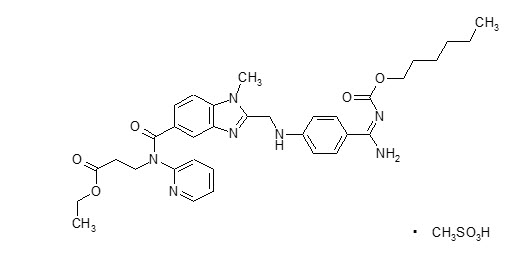
Dabigatran etexilate mesylate is a yellow-white to yellow powder. It is freely soluble in methanol, slightly soluble in ethanol, and sparingly soluble in isopropanol. A saturated solution in pure water has a solubility of 1.8 mg/mL.
Each packet of PRADAXA Oral Pellets contains 20 mg, 30 mg, 40 mg, 50 mg, 110 mg, or 150 mg dabigatran etexilate (equivalent to 23.06 mg, 34.59 mg, 46.12 mg, 57.65 mg, 126.83 mg, or 172.95 mg dabigatran etexilate mesylate) along with the following inactive ingredients: acacia, dimethicone, hydroxypropyl cellulose, hypromellose, talc, and tartaric acid.
-
12 CLINICAL PHARMACOLOGY
12.1 Mechanism of Action
Dabigatran and its acyl glucuronides are competitive, direct thrombin inhibitors. Because thrombin (serine protease) enables the conversion of fibrinogen into fibrin during the coagulation cascade, its inhibition prevents the development of a thrombus. Both free and clot-bound thrombin, and thrombin-induced platelet aggregation are inhibited by the active moieties.
12.2 Pharmacodynamics
At recommended therapeutic doses, dabigatran etexilate prolongs the coagulation markers such as aPTT, ECT, TT, and dTT. INR is relatively insensitive to the exposure to dabigatran and cannot be interpreted the same way as used for warfarin monitoring.
As in adults, there is a correlation between plasma dabigatran concentrations and the degree of its anticoagulant effect in pediatric patients with venous thromboembolism. The parameters dTT and ECT increased in direct linear proportion to the plasma concentration of dabigatran, whereas aPTT prolongation increases in a nonlinear fashion with dabigatran plasma concentrations.
Similar PK/PD relationships for aPTT, ECT and dTT were observed across age groups of pediatric patients (ages 26 days to < 18 years) and between pediatric and adult patients with venous thromboembolism. This similarity in PK/PD relationship suggests that similar exposure-response relationship is expected for dabigatran etexilate treatment across the pediatric age groups and adult patients.
12.3 Pharmacokinetics
Dabigatran etexilate mesylate is absorbed as the dabigatran etexilate ester. The ester is then hydrolyzed, forming dabigatran, the active moiety. Dabigatran is metabolized to four different acyl glucuronides and both the glucuronides and dabigatran have similar pharmacological activity. Pharmacokinetics described here refer to the sum of dabigatran and its glucuronides. Dabigatran displays dose-proportional pharmacokinetics in healthy adult subjects and adult patients in the range of doses from 10 mg to 400 mg. Given twice daily, dabigatran's accumulation factor in pediatric patients receiving pellets is 1.5-1.7.
Absorption
The absolute bioavailability of dabigatran following oral administration of dabigatran etexilate is approximately 3% to 7%. Dabigatran etexilate is a substrate of the efflux transporter P-gp. After oral administration of dabigatran etexilate in healthy volunteers, Cmax occurs at 1 hour post-administration in the fasted state. Coadministration of PRADAXA with a high-fat meal delays the time to Cmax by approximately 2 hours but has no effect on the bioavailability of dabigatran; PRADAXA may be administered with or without food.
PRADAXA is available in Capsules and Oral Pellets. The approved indications and intended age groups are not the same. Oral absorption of dabigatran etexilate is formulation-dependent. Dabigatran etexilate oral pellets show 37% higher relative bioavailability in healthy adults compared to dabigatran etexilate capsules. In addition, the relative bioavailability between the two dosage forms is age dependent. The relative bioavailability observed in adult patients cannot be translated to pediatric patients.
Distribution
Dabigatran is approximately 35% bound to human plasma proteins. The red blood cell to plasma partitioning of dabigatran measured as total radioactivity is less than 0.3. The volume of distribution of dabigatran is 50 to 70 L.
Elimination
Dabigatran is eliminated primarily in the urine. Renal clearance of dabigatran is 80% of total clearance after intravenous administration. After oral administration of radiolabeled dabigatran, 7% of radioactivity is recovered in urine and 86% in feces. The elimination half-life of dabigatran in pediatric patients receiving pellets is approximately 9 to 11 hours.
Metabolism
After oral administration, dabigatran etexilate is converted to dabigatran. The cleavage of the dabigatran etexilate by esterase-catalyzed hydrolysis to the active principal dabigatran is the predominant metabolic reaction. Dabigatran is not a substrate, inhibitor, or inducer of CYP450 enzymes. Dabigatran is subject to conjugation, forming pharmacologically active acyl glucuronides. Four positional isomers, 1-O, 2-O, 3-O, and 4-O-acylglucuronide exist, and each accounts for less than 10% of total dabigatran in plasma.
Specific Populations
Pediatric Patients
The pharmacokinetics of dabigatran was characterized in two clinical studies (DIVERSITY and Study 2) following multiple doses in pediatric patients from birth to less than 18 years old. In pediatric patients taking age- and weight-adjusted dosages of PRADAXA Oral Pellets (less than 12 years of age), the observed geometric mean steady-state trough concentration was 54.7 ng/mL (25.9 to 88.3 ng/mL, 10th to 90th percentile) compared to the geometric mean steady-state trough concentration of 59.7 ng/mL (26.3 to 146 ng/mL, 10th to 90th percentile) observed in adult patients with DVT/PE taking PRADAXA Capsules.
Renal Impairment
An open, parallel-group, single-center study compared dabigatran pharmacokinetics in healthy adult subjects and adult patients with mild to moderate renal impairment receiving a single dose of PRADAXA Capsules 150 mg. Exposure to dabigatran increases with severity of renal function impairment (Table 4). Similar findings were observed in the RE-LY, RE-COVER and RE-NOVATE II trials.
Table 4 Impact of Renal Impairment on Dabigatran Pharmacokinetics Renal Function CrCl
(mL/min)Increase in AUC Increase in Cmax t1/2
(h)+Patients with severe renal impairment were not studied in RE-LY, RE-COVER and RE-NOVATE II. Normal ≥ 80 1× 1× 13 Mild 50-80 1.5× 1.1× 15 Moderate 30-50 3.2× 1.7× 18 Severe+ 15-30 6.3× 2.1× 27 Drug Interactions
No clinical drug interaction studies have been conducted in pediatric subjects. A summary of the effect of coadministered drugs on dabigatran exposure in adult subjects is shown in Figures 1 and 2.
Figure 1 Effect of P-gp Inhibitor or Inducer (rifampicin) Drugs on Peak and Total Exposure to Dabigatran (Cmax and AUC). Shown are the Geometric Mean Ratios (Ratio) and 90% Confidence Interval (90% CI). The Perpetrator and Dabigatran Etexilate Dosage and Dosage Frequency are given as well as the Time of Perpetrator Dosage in Relation to Dabigatran Etexilate Dosage (Time Difference)
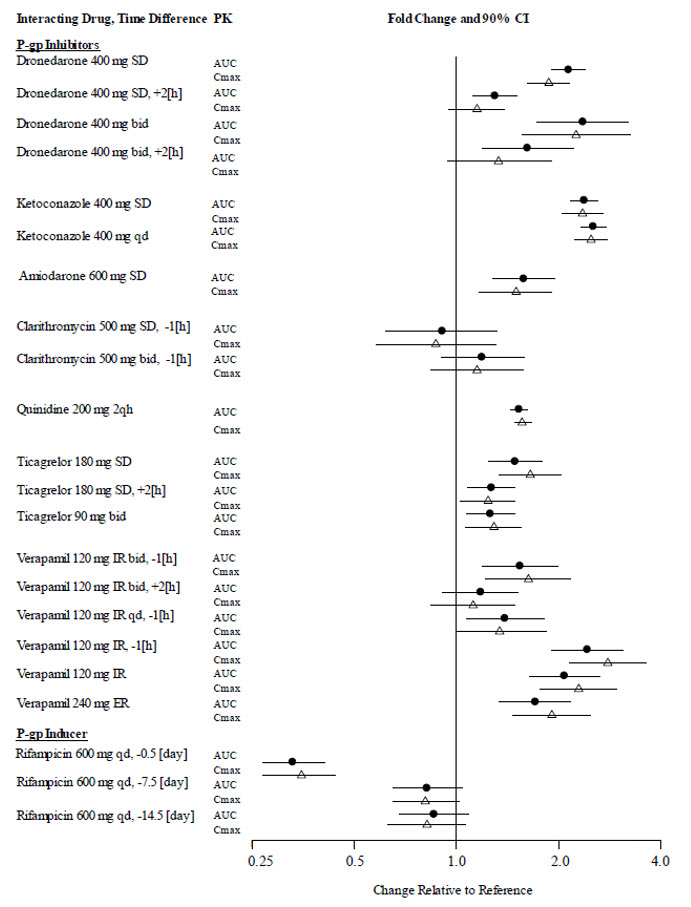
Figure 2 Effect of Non-P-gp Inhibitor or Inducer, Other Drugs, on Peak and Total Exposure to Dabigatran (Cmax and AUC). Shown are the Geometric Mean Ratios (Ratio) and 90% Confidence Interval (90% CI). The Perpetrator and Dabigatran Etexilate Dosage and Dosage Frequency are given as well as the Time of Perpetrator Dosage in Relation to Dabigatran Etexilate Dosage (Time Difference)

-
13 NONCLINICAL TOXICOLOGY
13.1 Carcinogenesis, Mutagenesis, Impairment of Fertility
Dabigatran was not carcinogenic when administered by oral gavage to mice and rats for up to 2 years. The highest doses tested (200 mg/kg/day) in mice and rats were approximately 3.6 and 6 times, respectively, the human exposure at MRHD of 300 mg/day based on AUC comparisons.
Dabigatran was not mutagenic in in vitro tests, including bacterial reversion tests, mouse lymphoma assay and chromosomal aberration assay in human lymphocytes, and the in vivo micronucleus assay in rats.
In the rat fertility study with oral gavage doses of 15, 70, and 200 mg/kg, males were treated for 29 days prior to mating, during mating up to scheduled termination, and females were treated 15 days prior to mating through gestation Day 6. No adverse effects on male or female fertility were observed at 200 mg/kg or 9 to 12 times the human exposure at MRHD of 300 mg/day based on AUC comparisons. However, the number of implantations decreased in females receiving 70 mg/kg, or 3 times the human exposure at MRHD based on AUC comparisons.
-
14 CLINICAL STUDIES
14.1 Treatment of VTE in Pediatric Patients
The DIVERSITY study was conducted to demonstrate the efficacy and safety of PRADAXA compared to standard of care (SOC) for the treatment of venous thromboembolism (VTE) in pediatric patients from birth to less than 18 years of age. The study was designed as an open-label, randomized, parallel-group, non-inferiority study. Patients enrolled were randomized according to a 2:1 scheme to either an age-appropriate formulation (capsules, oral pellets, or oral solution) of PRADAXA (dosages adjusted for age and weight) after at least 5 days and no longer than 21 days of treatment with a parenteral anticoagulant, or to SOC comprised of low molecular weight heparins (LMWH) or vitamin K antagonists (VKA) or fondaparinux. For patients on PRADAXA, drug concentration was determined prior to the 7th dose and a single titration was permitted to achieve drug target levels of 50-250 ng/ml. Inability to achieve target, after one up-titration, resulted in premature termination of study drug in 12 patients (6.8%).
The median treatment duration during the treatment period was 85 days. In total, 267 patients entered the study (leading index VTE was 64% deep vein thrombosis, 10% cerebral venous thrombosis or sinus thrombosis, and 9.0% pulmonary embolism), with 18% of patients having a central line-associated thrombosis. The patient population was 49.8% male, 91.8% white, 4.9% Asian, and 1.5% black; 168 patients were 12 to < 18 years old, 64 patients 2 to < 12 years, and 35 patients were younger than 2 years. The concomitant VTE-related risk factors of patients in this trial among study arms were as follows: inherited thrombophilia disorder (PRADAXA: 20%; SOC: 22%), congenital heart disease (PRADAXA: 12%; SOC: 30%), heart failure (PRADAXA: 3%; SOC: 18%), history of cancer (PRADAXA: 10%; SOC: 1%), CVL insertion (PRADAXA: 23%; SOC: 27%), immobility (PRADAXA: 13%; SOC: 10%) and significant infection (PRADAXA: 15%; SOC: 13%). The number of patients taking concomitant medications with hemostatic effects was similar in both treatment groups (PRADAXA: 15%; SOC: 16%).
The efficacy of PRADAXA was established based on a composite endpoint of patients with complete thrombus resolution, freedom from recurrent venous thromboembolic event, and freedom from mortality related to venous thromboembolic event (composite primary endpoint). Of the 267 randomized patients, 81 patients (45.8%) in the dabigatran etexilate group and 38 patients (42.2%) in the SOC group met the criteria for the composite primary endpoint. The corresponding rate difference and 95% CI was -0.038 (-0.161, 0.086) and thus demonstrated non-inferiority of PRADAXA to SOC, since the upper bound of the 95% CI was lower than the predefined non-inferiority margin of 20% (see Table 5).
Table 5 Efficacy Results [ITT population] DIVERSITY Study PRADAXA Standard of Care 1 Mantel-Haenszel weighted difference with age group as stratification factor Number of patients randomized (%) 177 (100.0) 90 (100.0) Complete thrombus resolution 81 (45.8) 38 (42.2) Freedom from recurrent VTE 170 (96.0) 83 (92.2) Freedom from mortality related to VTE 177 (100.0) 89 (98.9) Composite endpoint met 81 (45.8) 38 (42.2) Difference in rate (95% CI)1 -0.038 (-0.161, 0.086) p-value for non-inferiority < 0.0001 p-value for superiority 0.2739 Subgroup analyses showed that there were no outliers in the treatment effect for the subgroups by age, sex, region, and presence of certain risk factors (central venous line, congenital heart disease, malignant disease). For the 3 different age strata, the proportions of patients that met the efficacy endpoint in the PRADAXA and SOC groups, respectively, were 13/22 (59.1%) and 7/13 (53.8%) for patients from birth to < 2 years [Rate Difference -0.052; (95%CI: -0.393, 0.288)], 21/43 (48.8%) and 12/21 (57.1%) for patients aged 2 to < 12 years [Rate Difference 0.083; (95%CI: -0.176, 0.342)], and 47/112 (42.0%) and 19/56 (33.9%) for patients aged 12 to < 18 years [Rate Difference -0.080; (95%CI: -0.234, 0.074)].
14.2 Reduction in the Risk of Recurrence of VTE in Pediatric Patients
Study 2 was an open-label, single-arm safety study to assess the safety of PRADAXA for the prevention of recurrent VTE in pediatric patients from birth to < 18 years. Patients who required further anticoagulation due to the presence of a clinical risk factor after completing the initial treatment for confirmed VTE (for at least 3 months) or after completing the DIVERSITY study were included in the study. Eligible patients received age- and weight-adjusted dosages of an age-appropriate formulation (capsules or oral pellets) of PRADAXA until the clinical risk factor resolved, or up to a maximum of 12 months. The primary endpoints of the study included the recurrence of VTE, major and minor bleeding events, and mortality (overall and related to thrombotic or thromboembolic events) at 6 and 12 months.
Of the 214 patients in the study, 162 patients were 12 to < 18 years old, 43 patients were 2 to < 12 years old, and 9 patients were aged 6 months to < 2 years old.
The overall probability of being free from recurrence of VTE during the on-treatment period was 0.990 (95% CI: 0.960, 0.997) at 3 months, 0.984 (95% CI: 0.950, 0.995) at 6 months, and 0.984 (95% CI: 0.950, 0.995) at 12 months. The probability of being free from bleeding events during the on-treatment period was 0.849 (95% CI: 0.792, 0.891) at 3 months, 0.785 (95% CI: 0.718, 0.838) at 6 months, and 0.723 (95% CI: 0.645, 0.787) at 12 months. No on-treatment deaths occurred.
-
16 HOW SUPPLIED/STORAGE AND HANDLING
PRADAXA Oral Pellets are yellowish in a silver-colored, child-resistant packet. The packets are placed in an aluminum bag with a desiccant. PRADAXA Oral Pellets are supplied as follows:
Strength Package NDC 20 mg unit of use carton with 1 aluminum bag containing 60 packets 0597-0425-78 30 mg unit of use carton with 1 aluminum bag containing 60 packets 0597-0430-18 40 mg unit of use carton with 1 aluminum bag containing 60 packets 0597-0435-96 50 mg unit of use carton with 1 aluminum bag containing 60 packets 0597-0440-53 110 mg unit of use carton with 1 aluminum bag containing 60 packets 0597-0445-87 150 mg unit of use carton with 1 aluminum bag containing 60 packets 0597-0450-16 Store at 20°C to 25°C (68°F to 77°F); excursions permitted to 15°C to 30°C (59°F to 86°F) [see USP Controlled Room Temperature]. Store in the original package to protect from moisture.
Do not open the packets until ready for use. Use the PRADAXA Oral Pellets within 6 months of opening the aluminum bag containing the packets.
-
17 PATIENT COUNSELING INFORMATION
Advise the patient or caregiver to read the FDA-approved patient labeling (Medication Guide and Instruction for Use).
Instructions for Patients
- Tell patients or their caregivers to take or administer PRADAXA Oral Pellets exactly as prescribed.
- Tell patients or their caregivers to remove desiccant from the aluminum bag and throw away.
- Remind patients or their caregivers not to discontinue PRADAXA Oral Pellets without talking to the healthcare provider who prescribed it.
- Provide the following instructions on administration to the patients or caregivers:
- Take the prescribed dosage of PRADAXA Oral Pellets twice a day, approximately 12 hours apart;
- PRADAXA Oral Pellets may be sprinkled on mashed carrots, apple sauce, or mashed banana, or may be taken with approximately 1-2 ounces of apple juice;
- PRADAXA Oral Pellets should not be mixed with milk or with foods that contain milk;
- Once the PRADAXA Oral Pellets are mixed with the soft food or apple juice, the patient should take the dose within 30 minutes;
- If a dose of PRADAXA Oral Pellets is not taken at the scheduled time, the dose should be skipped if it cannot be taken at least 6 hours before the next scheduled dose. The dose of PRADAXA Oral Pellets should not be doubled to make up for a missed dose.
[see Boxed Warning, and Dosage and Administration (2.2, 2.4)]
Bleeding
Inform patients or their caregivers that they may bleed more easily, may bleed longer, and should call their healthcare provider for any signs or symptoms of bleeding [see Warnings and Precautions (5.2)].
Instruct patients or their caregivers to seek emergency care right away if they have any of the following, which may be a sign or symptom of serious bleeding:
- Unusual bruising (bruises that appear without known cause or that get bigger)
- Pink or brown urine
- Red or black, tarry stools
- Coughing up blood
- Vomiting blood, or vomit that looks like coffee grounds
Instruct patients or their caregivers to call their healthcare provider or to get prompt medical attention if they experience any signs or symptoms of bleeding:
- Pain, swelling or discomfort in a joint
- Headaches, dizziness, or weakness
- Reoccurring nose bleeds
- Unusual bleeding from gums
- Bleeding from a cut that takes a long time to stop
- Menstrual bleeding or vaginal bleeding that is heavier than normal
If patients have had neuraxial anesthesia or spinal puncture, and particularly, if they are taking concomitant NSAIDs or platelet inhibitors, advise patients or their caregivers to watch for signs and symptoms of spinal or epidural hematoma, such as back pain, tingling, numbness (especially in the lower limbs), muscle weakness, and stool or urine incontinence. If any of these symptoms occur, advise the patient or their caregivers to contact his or her physician immediately [see Boxed Warning].
Gastrointestinal Adverse Reactions
Instruct patients or their caregivers to call their healthcare provider if they experience any signs or symptoms of dyspepsia or gastritis:
- Dyspepsia (upset stomach), burning, or nausea
- Abdominal pain or discomfort
- Epigastric discomfort, GERD (gastric indigestion)
[see Adverse Reactions (6.1)]
Invasive or Surgical Procedures
Instruct patients or their caregivers to inform their healthcare provider that they are taking PRADAXA before any invasive procedure (including dental procedures) is scheduled [see Dosage and Administration (2.7)].
Concomitant Medications
Ask patients or their caregivers to list all prescription medications, over-the-counter medications, or dietary supplements they are taking or plan to take so the patient's healthcare provider knows about other treatments that may affect bleeding risk (e.g., aspirin or NSAIDs) or dabigatran exposure (e.g., dronedarone or systemic ketoconazole) [see Warnings and Precautions (5.2, 5.5)].
Prosthetic Heart Valves
Instruct patients or their caregivers to inform their healthcare provider if they will have or have had surgery to place a prosthetic heart valve [see Warnings and Precautions (5.4)].
Allergic Reactions
Advise caregivers that some adults taking PRADAXA have developed symptoms of an allergic reaction. Advise caregivers to inform their child's healthcare provider if their child develops symptoms of an allergic reaction, such as hives, rash, or itching. Advise caregivers to seek emergency medical attention for their child if they develop chest pain or tightness, swelling of the face or tongue, trouble breathing or wheezing, or feeling dizzy or faint.
Pregnancy
Advise patients to inform their healthcare provider immediately if they become pregnant or intend to become pregnant during treatment with PRADAXA [see Use in Specific Populations (8.1)].
Lactation
Advise patients not to breastfeed if they are taking PRADAXA [see Use in Specific Populations (8.2)].
- SPL UNCLASSIFIED SECTION
-
MEDICATION GUIDE
This Medication Guide has been approved by the U.S. Food and Drug Administration. Revised: 6/2025 MEDICATION GUIDE
PRADAXA (pra dax a)
(dabigatran etexilate)
Oral PelletsThis Medication Guide is for PRADAXA Oral Pellets. If your child is over 8 years of age and your healthcare provider prescribes PRADAXA Capsules for your child, read the Medication Guide that comes with your medicine.
Read this Medication Guide before you start giving PRADAXA Oral Pellets to your child and each time you get a refill. There may be new information. This Medication Guide does not take the place of talking with your healthcare provider about your child's medical condition or their treatment.What is the most important information I should know about PRADAXA?
Do not stop giving PRADAXA without talking to the healthcare provider who prescribes it for your child. Stopping PRADAXA increases your child's risk of a clot forming in their blood.
PRADAXA may need to be stopped, if possible, before surgery or a medical or dental procedure. Ask the healthcare provider who prescribed PRADAXA for your child when your child should stop taking it. Your healthcare provider will tell you when you may start giving PRADAXA to your child again after their surgery or procedure. If your child has to stop taking PRADAXA, your healthcare provider may prescribe another medicine to help prevent a blood clot from forming.- PRADAXA can cause bleeding which can be serious, and sometimes lead to death. This is because PRADAXA is a blood thinner medicine that lowers the chance of blood clots forming in the body.
-
Your child may have a higher risk of bleeding if your child takes PRADAXA and:
- has kidney problems
- has stomach or intestine bleeding that is recent or keeps coming back, or a stomach ulcer
- takes other medicines that increase the risk of bleeding, including:
- aspirin or aspirin-containing products
- long-term (chronic) use of non-steroidal anti-inflammatory drugs (NSAIDs)
- a medicine that contains warfarin sodium
- a medicine that contains heparin
- a medicine that contains clopidogrel bisulfate
- a medicine that contains prasugrel
- has certain kidney problems and also takes a medicine that contains dronedarone or ketoconazole tablets
- PRADAXA can increase your child's risk of bleeding because it lessens the ability of your child's blood to clot. During treatment with PRADAXA:
- he or she may bruise more easily
- it may take longer for any bleeding to stop
- unexpected bleeding or bleeding that lasts a long time, such as:
- unusual bleeding from the gums
- nose bleeds that happen often
- menstrual bleeding or vaginal bleeding that is heavier than normal
- bleeding that is severe or you cannot control
- pink or brown urine
- red or black stools (looks like tar)
- bruises that happen without a known cause or get larger
- cough up blood or blood clots
- vomit blood or your vomit looks like "coffee grounds"
- unexpected pain, swelling, or joint pain
- headaches, feeling dizzy or weak
-
Spinal or epidural blood clots (hematoma). People who take a blood thinner medicine (anticoagulant) like PRADAXA, and have medicine injected into their spinal and epidural area, or have a spinal puncture have a risk of forming a blood clot that can cause long-term or permanent loss of the ability to move (paralysis). Your child's risk of developing a spinal or epidural blood clot is higher if:
- a thin tube called an epidural catheter is placed in your child's back to give them certain medicine
- your child takes NSAIDs or a medicine to prevent blood from clotting
- your child has a history of difficult or repeated epidural or spinal punctures
- your child has a history of problems with their spine or has had surgery on their spine
What is PRADAXA Oral Pellets?
PRADAXA Oral Pellets is a prescription medicine that is used to:- treat blood clots in children who are age 3 months to less than 12 years of age who have received an injectable medicine to treat their blood clots for at least 5 days.
- reduce the risk of blood clots happening again in children who are age 3 months to less than 12 years of age who have already been treated for blood clots.
Do not give PRADAXA if your child: - currently has certain types of abnormal bleeding. Talk to your healthcare provider before giving PRADAXA if your child currently has unusual bleeding.
- has had a serious allergic reaction to any of the ingredients in PRADAXA. See the end of this Medication Guide for a complete list of ingredients in PRADAXA. Ask your healthcare provider if you are not sure.
- has ever had or if there are plans for your child to have a valve in their heart replaced with a mechanical (artificial) prosthetic heart valve.
Before giving PRADAXA to your child, tell your healthcare provider about all of your child's medical conditions, including if they: - have kidney problems
- have ever had bleeding problems
- have ever had stomach ulcers
- have antiphospholipid syndrome (APS)
- are pregnant or plan to become pregnant. It is not known if PRADAXA will harm your child's unborn baby.
- If your child is able to become pregnant, talk with your healthcare provider about your child's risk for severe uterine bleeding during treatment with blood thinner medicines, including PRADAXA.
- Tell your healthcare provider right away if your child becomes pregnant during treatment with PRADAXA Oral Pellets.
- are breastfeeding or plan to breastfeed. It is not known if PRADAXA passes into your child's breastmilk. Your child should not breastfeed during treatment with PRADAXA.
Tell your healthcare provider about all the medicines your child takes, including prescription and over-the-counter medicines, vitamins, and herbal supplements.
Some of your child's other medicines may affect the way PRADAXA works. Certain medicines may increase your child's risk of bleeding. See "What is the most important information I should know about PRADAXA?"
Especially tell your healthcare provider if your child takes a medicine that contains rifampin.
Know the medicines your child takes. Keep a list of them and show it to your healthcare provider and pharmacist when your child gets a new medicine.How should I give PRADAXA? - See the detailed "Instructions for Use" that comes with PRADAXA Oral Pellets for information about the right way to prepare and give your child a dose of PRADAXA Oral Pellets.
- Your healthcare provider will decide how long your child should take PRADAXA Oral Pellets. Do not stop giving your child PRADAXA Oral Pellets without first talking with your healthcare provider. Stopping PRADAXA Oral Pellets may increase your child's risk of forming blood clots.
- Give PRADAXA Oral Pellets exactly as prescribed by your healthcare provider. Check with your healthcare provider if you are not sure.
- Your healthcare provider will prescribe the correct dose of PRADAXA Oral Pellets for your child. Your healthcare provider will change your child's dose as they grow, and as needed during treatment.
- Give PRADAXA Oral Pellets 2 times a day, 1 dose in the morning and 1 dose in the evening. The doses should be given as close as possible to every 12 hours, and at about the same time every day.
- Give PRADAXA Oral Pellets before meals to help ensure that your child takes the full dose.
- You can mix PRADAXA Oral Pellets with apple juice or the following soft foods at room temperature:
- Mashed carrots
- Apple sauce
- Mashed bananas
- Do not mix PRADAXA Oral Pellets with any food or liquid other than the ones listed above.
- Do not mix PRADAXA Oral Pellets with milk or with foods that contain milk.
- Give PRADAXA Oral Pellets right away or within 30 minutes after mixing. Do not give PRADAXA Oral Pellets if they have been in contact with the soft food or apple juice for more than 30 minutes.
- Do not give PRADAXA Oral Pellets using a syringe or through a feeding tube.
- Do not run out of PRADAXA Oral Pellets. Refill your child's prescription before you run out.
- If you plan for your child to have surgery, or a medical or a dental procedure, tell your healthcare provider and dentist that your child is taking PRADAXA Oral Pellets. Your child may have to stop taking PRADAXA Oral Pellets for a short time. See "What is the most important information I should know about PRADAXA?"
- If your child only takes part of their dose, do not give another dose at that time. Give your child their next dose at the regular scheduled time, about 12 hours later.
- If your child misses a dose of PRADAXA Oral Pellets, give it as soon as you remember. If your child's next dose is less than 6 hours away, skip the missed dose. Do not give your child a double dose of PRADAXA Oral Pellets to make up for a missed dose.
- If your child takes too much PRADAXA Oral Pellets, go to the nearest hospital emergency room or call your healthcare provider right away.
- Call your healthcare provider right away if your child falls or injures himself, especially if your child hits his head. Your healthcare provider may need to check your child.
What are the possible side effects of PRADAXA?
PRADAXA can cause serious side effects. See "What is the most important information I should know about PRADAXA?"-
Allergic Reactions. Some adults taking PRADAXA Capsules have developed symptoms of an allergic reaction.
- Call your healthcare provider if your child gets symptoms of an allergic reaction, such as:
- hives
- rash
- itching
- Get medical help right away if your child gets any of the following symptoms of a serious allergic reaction with PRADAXA Oral Pellets:
- chest pain or chest tightness
- swelling of the face or tongue
- trouble breathing or wheezing
- feeling dizzy or faint
Common side effects of PRADAXA in children include: - indigestion, upset stomach, burning
- nausea, vomiting, or diarrhea
- stomach-area (abdominal) pain or discomfort
Tell your healthcare provider if your child has any side effect that bothers them or that does not go away.
These are not all of the possible side effects of PRADAXA. For more information, ask your healthcare provider or pharmacist.
Call your doctor for medical advice about side effects. You may report side effects to FDA at 1-800-FDA-1088.How should I store PRADAXA Oral Pellets? - Store PRADAXA Oral Pellets at room temperature 68°F to 77°F (20°C to 25°C).
- After opening the silver aluminum bag that contains the packets of Oral Pellets:
- The silver aluminum bag contains a desiccant container. Throw away (dispose of) the desiccant container in your household trash.
- PRADAXA Oral Pellets must be used within 6 months. Safely throw away any unused PRADAXA Oral Pellets after 6 months.
- Keep PRADAXA Oral Pellets packets in the original silver aluminum bag to keep them dry (protect the packets from moisture). Do not open packets of PRADAXA Oral Pellets until you are ready to use them.
- Throw away any PRADAXA Oral Pellets that have not been given within 30 minutes after the Oral Pellets come into contact with apple juice or soft food.
General information about the safe and effective use of PRADAXA
Medicines are sometimes prescribed for purposes other than those listed in a Medication Guide. Do not use PRADAXA for a condition for which it was not prescribed. Do not give PRADAXA to other people, even if they have the same symptoms that your child has. It may harm them.
This Medication Guide summarizes the most important information about PRADAXA. If you would like more information, talk with your child's healthcare provider. You can ask your child's pharmacist or healthcare provider for information about PRADAXA that is written for health professionals.What are the ingredients in PRADAXA Oral Pellets?
Active ingredient: dabigatran etexilate mesylate
Inactive ingredients: acacia, dimethicone, hydroxypropyl cellulose, hypromellose, talc, and tartaric acid.
Distributed by: Boehringer Ingelheim Pharmaceuticals, Inc. Ridgefield, CT 06877 USA
For more information about PRADAXA Oral Pellets, call Boehringer Ingelheim Pharmaceuticals, Inc. at 1-800-542-6257.
Copyright © 2025 Boehringer Ingelheim Pharmaceuticals, Inc.
ALL RIGHTS RESERVED
COL8834FF232025 -
Instructions for UsePRADAXA (pra dax a)(dabigatran etexilate)Oral Pellets
Read the Medication Guide and this Instructions for Use that come with PRADAXA Oral Pellets for the most important information you need to know before giving PRADAXA Oral Pellets to your child for the first time, and each time you get a refill. The information may have changed. This Instructions for Use does not take the place of talking to your healthcare provider about your child's medical condition or treatment.
Your healthcare provider should tell you the amount (dose) of PRADAXA Oral Pellets to give your child. Your child's dose of PRADAXA Oral Pellets will change as they grow.
Important Information
- PRADAXA Oral Pellets can be used in children as soon as they are able to swallow soft food
- Do not open the packets of PRADAXA Oral Pellets until you are ready to use them
- Give PRADAXA Oral Pellets either with soft foods or apple juice
- Do not give PRADAXA Oral Pellets using syringes or through feeding tubes
- Do not mix PRADAXA Oral Pellets with milk or soft foods containing milk products
- Give your child the prepared dose of PRADAXA Oral Pellets before meals to help ensure that your child takes the full dose
- Give PRADAXA Oral Pellets to your child right away or within 30 minutes after mixing
- Do not give PRADAXA Oral Pellets if they have been in contact with the food or apple juice for more than 30 minutes
- If your child does not take all of the mixed PRADAXA Oral Pellets, do not give another dose at that time. Give the next scheduled dose about 12 hours later.
- If a dose of PRADAXA Oral Pellets is not taken at the scheduled time, the dose should be taken as soon as possible on the same day; the missed dose should be skipped if it cannot be taken at least 6 hours before the next scheduled dose. The dose of PRADAXA Oral Pellets should not be doubled to make up for a missed dose.
Instructions are provided below for preparing and giving a dose of PRADAXA Oral Pellets with soft foods and preparing and giving a dose of PRADAXA Oral Pellets with apple juice.
How to prepare and give a dose of PRADAXA Oral Pellets with soft foods:
The food should be at room temperature before mixing with the pellets. Use only one of the following soft foods:
- Mashed carrots
- Apple sauce (for administration with apple juice see below)
- Mashed banana
Do not mix with milk, milk products, or soft foods containing milk products.
Step 1 – Prepare cup or bowl - Place 2 teaspoons of the soft food into a small cup or bowl.
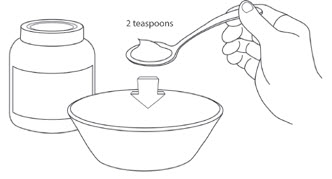
Step 2 – Collect PRADAXA Oral Pellets packet(s) - Open the silver aluminum bag by cutting at the top with scissors. The aluminum bag contains 60 silver-colored packets of PRADAXA Oral Pellets and a desiccant container.
- Remove desiccant container from silver aluminum bag. Throw away (dispose of) desiccant container in your household trash.
- Do not open or eat the desiccant.
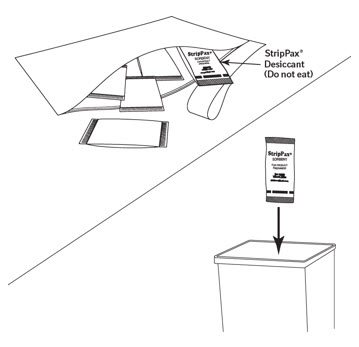
- Remove the prescribed number of PRADAXA Oral Pellets packets from the silver aluminum bag.
- Leave the unused packets of PRADAXA Oral Pellets in the silver aluminum bag.

Step 3 – Open the PRADAXA Oral Pellets packet(s) - Tap the packet of Oral Pellets on a flat surface to ensure that the contents settle to the bottom.
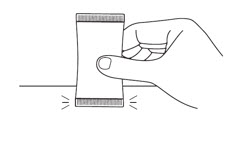
- Keep the packet of Oral Pellets in an upright position and open the packet by cutting at the top with scissors.
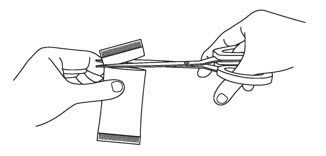
Step 4 – Add the PRADAXA Oral Pellets to soft food - Empty the entire packet into the small cup or bowl containing the soft food.
- Repeat Steps 3 and 4 if more than one packet is needed.
- Throw away the empty packets in your household trash.

Step 5 – Stir the soft food to mix with the PRADAXA Oral Pellets - Stir the pellets into the soft food with a spoon to mix well.
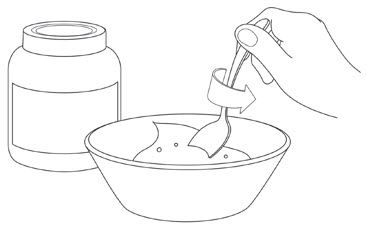
Step 6 – Give the soft food and oral pellet mixture - Give the soft food and oral pellet mixture to your child right away.
- Make sure that your child eats all of the soft food and oral pellet mixture.
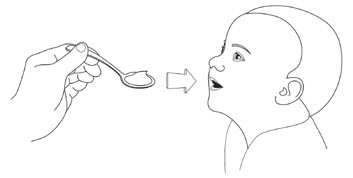
How to prepare and give a dose of PRADAXA Oral Pellets with apple juice:
Step 1 – Pour about 1 to 2 ounces of apple juice into a clean drinking cup.
Step 2 – Collect PRADAXA Oral Pellets packet(s)- Open the silver aluminum bag by cutting at the top with scissors. The silver aluminum bag includes 60 silver-colored packets of pellets and a desiccant container.
- Remove desiccant container from silver aluminum bag. Throw away (dispose of) desiccant container in your household trash.
- Do not open or eat the desiccant.

- Remove the prescribed number of PRADAXA Oral Pellets packets from the silver aluminum bag.
- Leave the unused packets of PRADAXA Oral Pellets in the silver aluminum bag.
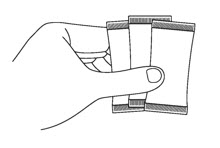
Step 3 – Open PRADAXA Oral Pellets packet(s) - Tap the packet on a flat surface to make sure that the contents settle to the bottom.
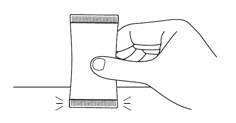
- Keep the packet in an upright position and open the packet by cutting at the top with scissors.
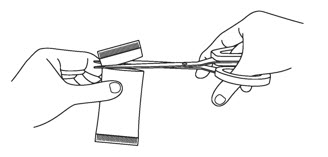
Step 4 – Mix the PRADAXA Oral Pellets with apple juice - Spoon the PRADAXA Oral Pellets from the packet into your child's mouth. Offer your child as much apple juice as needed to swallow the PRADAXA Oral Pellets. Make sure all of the PRADAXA Oral Pellets are swallowed.
OR
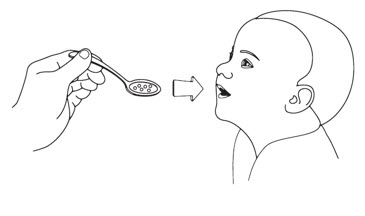
- Mix the PRADAXA Oral Pellets in a small amount of apple juice that your child is likely to drink completely. Make sure all of the PRADAXA Oral Pellets are swallowed. If any of the PRADAXA Oral Pellets stick to the cup, add a little more apple juice and give it to your child. Repeat until no PRADAXA Oral Pellets remain in the cup.
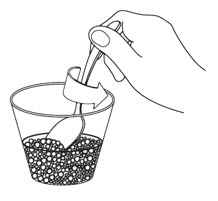
Storing PRADAXA Oral Pellets
- Store PRADAXA Oral Pellets at room temperature from 68°F to 77°F (20°C to 25°C).
- After opening the silver aluminum bag that contains the packets of Oral Pellets:
- The silver aluminum bag contains a desiccant container. Throw away (dispose of) the desiccant container in your household trash.
- PRADAXA Oral Pellets must be used within 6 months. Safely throw away any unused PRADAXA Oral Pellets after 6 months.
- Keep PRADAXA Oral Pellets packets in the original silver aluminum bag to keep them dry (protect the packets from moisture). Do not open packets of PRADAXA Oral Pellets until you are ready to use them.
- Throw away any PRADAXA Oral Pellets that have not been given within 30 minutes after the Oral Pellets come into contact with apple juice or food.
Keep PRADAXA Oral Pellets and all medicines out of the reach of children.
For more information about PRADAXA Oral Pellets, call Boehringer Ingelheim Pharmaceuticals, Inc. at 1-800-542-6257.
Distributed by: Boehringer Ingelheim Pharmaceuticals, Inc. Ridgefield, CT 06877 USA
Copyright © 2025 Boehringer Ingelheim Pharmaceuticals, Inc.
ALL RIGHTS RESERVEDCOL8834FF232025
This Instructions for Use has been approved by the U.S. Food and Drug Administration.
Revised: 6/2025 -
PRINCIPAL DISPLAY PANEL - 20 mg Packet Bag Carton
NDC: 0597-0425-78
DISPENSE IN THIS UNIT OF USE CONTAINER
WITH ENCLOSED MEDICATION GUIDEPradaxa®
(dabigatran etexilate)
Oral Pellets20 mg* per packet
Pradaxa oral pellets are NOT substitutable on a mg-to-mg basis with other dabigatran
etexilate dosage forms.Do not open PRADAXA packets until you are ready to use them. Discard unused
PRADAXA oral pellets 6 months after first opening the aluminum bag.1 aluminum bag containing 60 packets
Rx onlyBoehringer
Ingelheim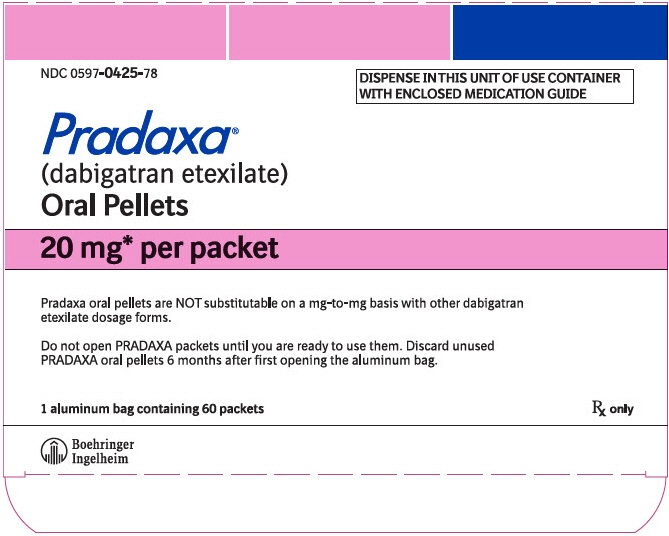
-
PRINCIPAL DISPLAY PANEL - 30 mg Packet Bag Carton
NDC: 0597-0430-18
DISPENSE IN THIS UNIT OF USE CONTAINER
WITH ENCLOSED MEDICATION GUIDEPradaxa®
(dabigatran etexilate)
Oral Pellets30 mg* per packet
Pradaxa oral pellets are NOT substitutable on a mg-to-mg basis with other dabigatran
etexilate dosage forms.Do not open PRADAXA packets until you are ready to use them. Discard unused
PRADAXA oral pellets 6 months after first opening the aluminum bag.1 aluminum bag containing 60 packets
Rx onlyBoehringer
Ingelheim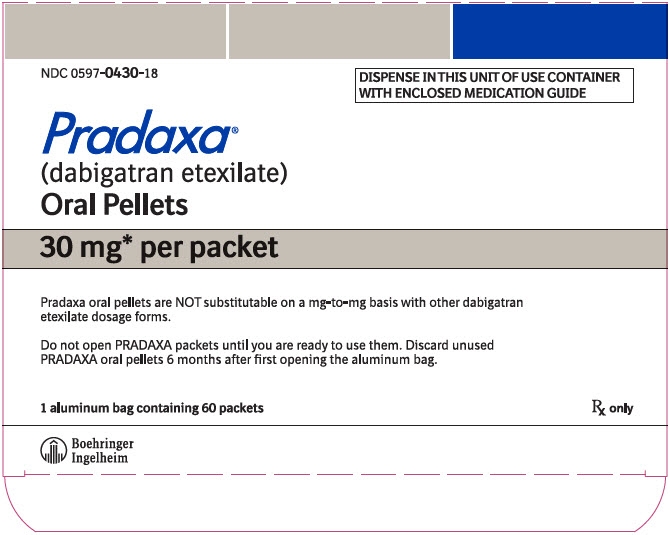
-
PRINCIPAL DISPLAY PANEL - 40 mg Packet Bag Carton
NDC: 0597-0435-96
DISPENSE IN THIS UNIT OF USE CONTAINER
WITH ENCLOSED MEDICATION GUIDEPradaxa®
(dabigatran etexilate)
Oral Pellets40 mg* per packet
Pradaxa oral pellets are NOT substitutable on a mg-to-mg basis with other dabigatran
etexilate dosage forms.Do not open PRADAXA packets until you are ready to use them. Discard unused
PRADAXA oral pellets 6 months after first opening the aluminum bag.1 aluminum bag containing 60 packets
Rx onlyBoehringer
Ingelheim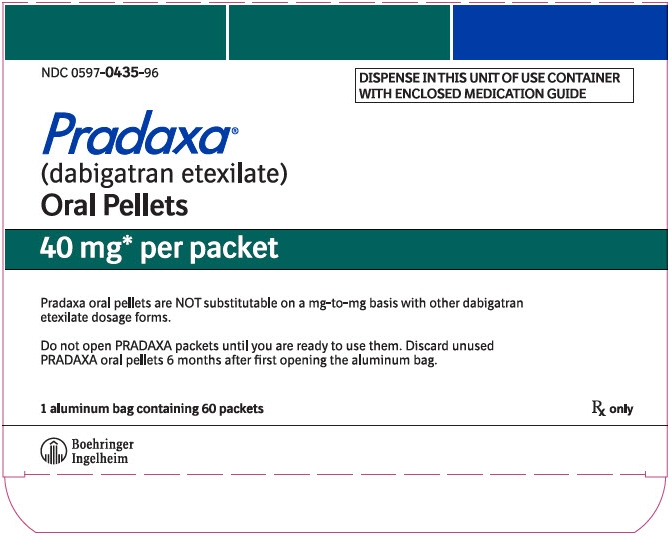
-
PRINCIPAL DISPLAY PANEL - 50 mg Packet Bag Carton
NDC: 0597-0440-53
DISPENSE IN THIS UNIT OF USE CONTAINER
WITH ENCLOSED MEDICATION GUIDEPradaxa®
(dabigatran etexilate)
Oral Pellets50 mg* per packet
Pradaxa oral pellets are NOT substitutable on a mg-to-mg basis with other dabigatran
etexilate dosage forms.Do not open PRADAXA packets until you are ready to use them. Discard unused
PRADAXA oral pellets 6 months after first opening the aluminum bag.1 aluminum bag containing 60 packets
Rx onlyBoehringer
Ingelheim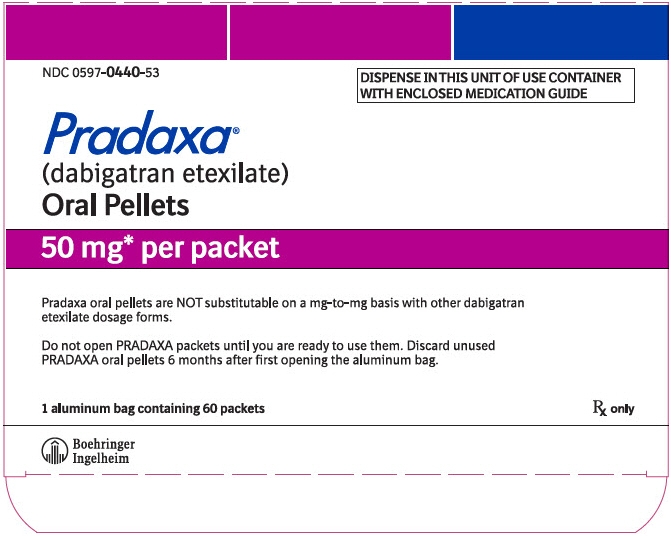
-
PRINCIPAL DISPLAY PANEL - 110 mg Packet Bag Carton
NDC: 0597-0445-87
DISPENSE IN THIS UNIT OF USE CONTAINER
WITH ENCLOSED MEDICATION GUIDEPradaxa®
(dabigatran etexilate)
Oral Pellets110 mg* per packet
Pradaxa oral pellets are NOT substitutable on a mg-to-mg basis with other dabigatran
etexilate dosage forms.Do not open PRADAXA packets until you are ready to use them. Discard unused
PRADAXA oral pellets 6 months after first opening the aluminum bag.1 aluminum bag containing 60 packets
Rx onlyBoehringer
Ingelheim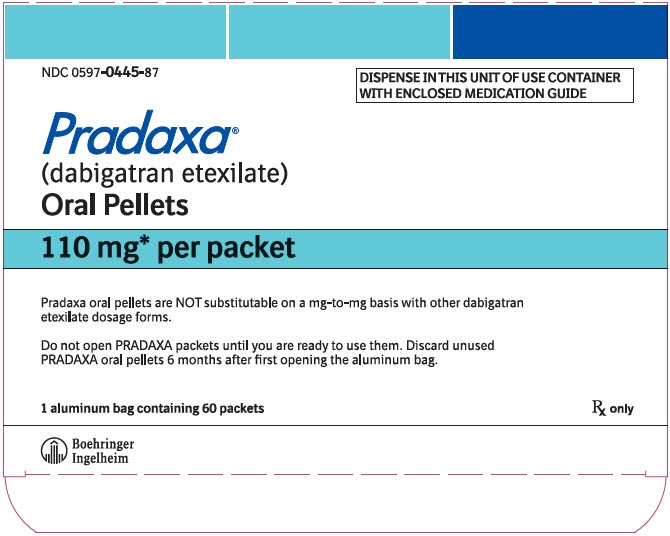
-
PRINCIPAL DISPLAY PANEL - 150 mg Packet Bag Carton
NDC: 0597-0450-16
DISPENSE IN THIS UNIT OF USE CONTAINER
WITH ENCLOSED MEDICATION GUIDEPradaxa®
(dabigatran etexilate)
Oral Pellets150 mg* per packet
Pradaxa oral pellets are NOT substitutable on a mg-to-mg basis with other dabigatran
etexilate dosage forms.Do not open PRADAXA packets until you are ready to use them. Discard unused
PRADAXA oral pellets 6 months after first opening the aluminum bag.1 aluminum bag containing 60 packets
Rx onlyBoehringer
Ingelheim
-
INGREDIENTS AND APPEARANCE
PRADAXA
dabigatran etexilate pelletProduct Information Product Type HUMAN PRESCRIPTION DRUG Item Code (Source) NDC: 0597-0425 Route of Administration ORAL Active Ingredient/Active Moiety Ingredient Name Basis of Strength Strength DABIGATRAN ETEXILATE MESYLATE (UNII: SC7NUW5IIT) (DABIGATRAN - UNII:I0VM4M70GC) DABIGATRAN ETEXILATE 20 mg Inactive Ingredients Ingredient Name Strength ACACIA (UNII: 5C5403N26O) DIMETHICONE (UNII: 92RU3N3Y1O) HYPROMELLOSE, UNSPECIFIED (UNII: 3NXW29V3WO) HYDROXYPROPYL CELLULOSE (1600000 WAMW) (UNII: RFW2ET671P) TALC (UNII: 7SEV7J4R1U) TARTARIC ACID (UNII: W4888I119H) Product Characteristics Color YELLOW (yellow-white) Score Shape Size Flavor Imprint Code Contains Packaging # Item Code Package Description Marketing Start Date Marketing End Date 1 NDC: 0597-0425-78 1 in 1 CARTON 03/16/2022 1 60 in 1 BAG; Type 0: Not a Combination Product Marketing Information Marketing Category Application Number or Monograph Citation Marketing Start Date Marketing End Date NDA NDA214358 03/16/2022 PRADAXA
dabigatran etexilate pelletProduct Information Product Type HUMAN PRESCRIPTION DRUG Item Code (Source) NDC: 0597-0430 Route of Administration ORAL Active Ingredient/Active Moiety Ingredient Name Basis of Strength Strength DABIGATRAN ETEXILATE MESYLATE (UNII: SC7NUW5IIT) (DABIGATRAN - UNII:I0VM4M70GC) DABIGATRAN ETEXILATE 30 mg Inactive Ingredients Ingredient Name Strength ACACIA (UNII: 5C5403N26O) DIMETHICONE (UNII: 92RU3N3Y1O) HYPROMELLOSE, UNSPECIFIED (UNII: 3NXW29V3WO) HYDROXYPROPYL CELLULOSE (1600000 WAMW) (UNII: RFW2ET671P) TALC (UNII: 7SEV7J4R1U) TARTARIC ACID (UNII: W4888I119H) Product Characteristics Color YELLOW (yellow-white) Score Shape Size Flavor Imprint Code Contains Packaging # Item Code Package Description Marketing Start Date Marketing End Date 1 NDC: 0597-0430-18 1 in 1 CARTON 03/16/2022 1 60 in 1 BAG; Type 0: Not a Combination Product Marketing Information Marketing Category Application Number or Monograph Citation Marketing Start Date Marketing End Date NDA NDA214358 03/16/2022 PRADAXA
dabigatran etexilate pelletProduct Information Product Type HUMAN PRESCRIPTION DRUG Item Code (Source) NDC: 0597-0435 Route of Administration ORAL Active Ingredient/Active Moiety Ingredient Name Basis of Strength Strength DABIGATRAN ETEXILATE MESYLATE (UNII: SC7NUW5IIT) (DABIGATRAN - UNII:I0VM4M70GC) DABIGATRAN ETEXILATE 40 mg Inactive Ingredients Ingredient Name Strength ACACIA (UNII: 5C5403N26O) DIMETHICONE (UNII: 92RU3N3Y1O) HYPROMELLOSE, UNSPECIFIED (UNII: 3NXW29V3WO) HYDROXYPROPYL CELLULOSE (1600000 WAMW) (UNII: RFW2ET671P) TALC (UNII: 7SEV7J4R1U) TARTARIC ACID (UNII: W4888I119H) Product Characteristics Color YELLOW (yellow-white) Score Shape Size Flavor Imprint Code Contains Packaging # Item Code Package Description Marketing Start Date Marketing End Date 1 NDC: 0597-0435-96 1 in 1 CARTON 03/16/2022 1 60 in 1 BAG; Type 0: Not a Combination Product Marketing Information Marketing Category Application Number or Monograph Citation Marketing Start Date Marketing End Date NDA NDA214358 03/16/2022 PRADAXA
dabigatran etexilate pelletProduct Information Product Type HUMAN PRESCRIPTION DRUG Item Code (Source) NDC: 0597-0440 Route of Administration ORAL Active Ingredient/Active Moiety Ingredient Name Basis of Strength Strength DABIGATRAN ETEXILATE MESYLATE (UNII: SC7NUW5IIT) (DABIGATRAN - UNII:I0VM4M70GC) DABIGATRAN ETEXILATE 50 mg Inactive Ingredients Ingredient Name Strength ACACIA (UNII: 5C5403N26O) DIMETHICONE (UNII: 92RU3N3Y1O) HYPROMELLOSE, UNSPECIFIED (UNII: 3NXW29V3WO) HYDROXYPROPYL CELLULOSE (1600000 WAMW) (UNII: RFW2ET671P) TALC (UNII: 7SEV7J4R1U) TARTARIC ACID (UNII: W4888I119H) Product Characteristics Color YELLOW (yellow-white) Score Shape Size Flavor Imprint Code Contains Packaging # Item Code Package Description Marketing Start Date Marketing End Date 1 NDC: 0597-0440-53 1 in 1 CARTON 03/16/2022 1 60 in 1 BAG; Type 0: Not a Combination Product Marketing Information Marketing Category Application Number or Monograph Citation Marketing Start Date Marketing End Date NDA NDA214358 03/16/2022 PRADAXA
dabigatran etexilate pelletProduct Information Product Type HUMAN PRESCRIPTION DRUG Item Code (Source) NDC: 0597-0445 Route of Administration ORAL Active Ingredient/Active Moiety Ingredient Name Basis of Strength Strength DABIGATRAN ETEXILATE MESYLATE (UNII: SC7NUW5IIT) (DABIGATRAN - UNII:I0VM4M70GC) DABIGATRAN ETEXILATE 110 mg Inactive Ingredients Ingredient Name Strength ACACIA (UNII: 5C5403N26O) DIMETHICONE (UNII: 92RU3N3Y1O) HYPROMELLOSE, UNSPECIFIED (UNII: 3NXW29V3WO) HYDROXYPROPYL CELLULOSE (1600000 WAMW) (UNII: RFW2ET671P) TALC (UNII: 7SEV7J4R1U) TARTARIC ACID (UNII: W4888I119H) Product Characteristics Color YELLOW (yellow-white) Score Shape Size Flavor Imprint Code Contains Packaging # Item Code Package Description Marketing Start Date Marketing End Date 1 NDC: 0597-0445-87 1 in 1 CARTON 03/16/2022 1 60 in 1 BAG; Type 0: Not a Combination Product Marketing Information Marketing Category Application Number or Monograph Citation Marketing Start Date Marketing End Date NDA NDA214358 03/16/2022 PRADAXA
dabigatran etexilate pelletProduct Information Product Type HUMAN PRESCRIPTION DRUG Item Code (Source) NDC: 0597-0450 Route of Administration ORAL Active Ingredient/Active Moiety Ingredient Name Basis of Strength Strength DABIGATRAN ETEXILATE MESYLATE (UNII: SC7NUW5IIT) (DABIGATRAN - UNII:I0VM4M70GC) DABIGATRAN ETEXILATE 150 mg Inactive Ingredients Ingredient Name Strength ACACIA (UNII: 5C5403N26O) DIMETHICONE (UNII: 92RU3N3Y1O) HYPROMELLOSE, UNSPECIFIED (UNII: 3NXW29V3WO) HYDROXYPROPYL CELLULOSE (1600000 WAMW) (UNII: RFW2ET671P) TALC (UNII: 7SEV7J4R1U) TARTARIC ACID (UNII: W4888I119H) Product Characteristics Color YELLOW (yellow-white) Score Shape Size Flavor Imprint Code Contains Packaging # Item Code Package Description Marketing Start Date Marketing End Date 1 NDC: 0597-0450-16 1 in 1 CARTON 03/16/2022 1 60 in 1 BAG; Type 0: Not a Combination Product Marketing Information Marketing Category Application Number or Monograph Citation Marketing Start Date Marketing End Date NDA NDA214358 03/16/2022 Labeler - Boehringer Ingelheim Pharmaceuticals, Inc. (603175944) Registrant - Boehringer Ingelheim Pharmaceuticals, Inc. (603175944) Establishment Name Address ID/FEI Business Operations Bidachem S.p.a. 429232812 API MANUFACTURE(0597-0425, 0597-0430, 0597-0435, 0597-0440, 0597-0445, 0597-0450) Establishment Name Address ID/FEI Business Operations Boehringer Ingelheim Pharma GmbH and Co. KG 551147440 MANUFACTURE(0597-0425, 0597-0430, 0597-0435, 0597-0440, 0597-0445, 0597-0450) Establishment Name Address ID/FEI Business Operations Catalent Germany Schorndorf GmbH 315732628 PACK(0597-0425, 0597-0430, 0597-0435, 0597-0440, 0597-0445, 0597-0450) , LABEL(0597-0425, 0597-0430, 0597-0435, 0597-0440, 0597-0445, 0597-0450) Establishment Name Address ID/FEI Business Operations Sixarp, LLC 016329513 PACK(0597-0425, 0597-0430, 0597-0435, 0597-0440, 0597-0445, 0597-0450) , LABEL(0597-0425, 0597-0430, 0597-0435, 0597-0440, 0597-0445, 0597-0450)
Trademark Results [Pradaxa]
Mark Image Registration | Serial | Company Trademark Application Date |
|---|---|
 PRADAXA 85133694 3977066 Live/Registered |
Boehringer Ingelheim Pharma GmbH & Co.,KG 2010-09-20 |
 PRADAXA 79193638 5173798 Live/Registered |
Boehringer Ingelheim Pharma GmbH & Co KG 2016-04-06 |
 PRADAXA 79064548 3661185 Dead/Cancelled |
Boehringer Ingelheim Pharma GmbH & Co. KG 2008-10-29 |
 PRADAXA 78282869 2874805 Live/Registered |
Boehringer Ingelheim Pharma GmbH & Co. KG 2003-08-04 |
© 2025 FDA.report
This site is not affiliated with or endorsed by the FDA.